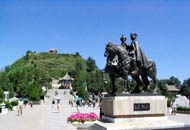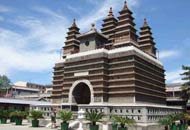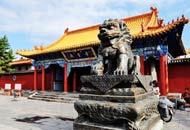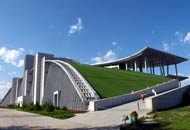 70 kilometers (approx. 43 miles) northeast of Baotou, near a valley named Wudang Gou, lies the Wudangzhao Monastery which is a large Tibetan Buddhist monastery. It is the biggest and the best preserved lama monastery in Inner Mongolia’s Autonomous Region. ‘Bada Gele Monastery’ is its Tibetan name, meaning white lotus. ‘Wudangzhao’ in Mongolian means ‘willow’. Willows are prosperous in the valley, thus the name.At its most prosperous time, there were more than 1200 lamas in the temple.The Tibetan style construction of the monastery is similar to the style of Tashilumpo Monastery in Tibet and is attractive. All the palaces, halls and rooms in the monastery are constructed in the traditional Tibetan style. In the monastery, there are many lections in Tibetan language and most precious art treasures such as the figures of Buddha and the murals made of gold, silver, bronze, wood and mud.
70 kilometers (approx. 43 miles) northeast of Baotou, near a valley named Wudang Gou, lies the Wudangzhao Monastery which is a large Tibetan Buddhist monastery. It is the biggest and the best preserved lama monastery in Inner Mongolia’s Autonomous Region. ‘Bada Gele Monastery’ is its Tibetan name, meaning white lotus. ‘Wudangzhao’ in Mongolian means ‘willow’. Willows are prosperous in the valley, thus the name.At its most prosperous time, there were more than 1200 lamas in the temple.The Tibetan style construction of the monastery is similar to the style of Tashilumpo Monastery in Tibet and is attractive. All the palaces, halls and rooms in the monastery are constructed in the traditional Tibetan style. In the monastery, there are many lections in Tibetan language and most precious art treasures such as the figures of Buddha and the murals made of gold, silver, bronze, wood and mud.
The Wudangzhao Monastery is not only the largest lamasery in Inner Mongolia but also the best preserved. This monastery is impressive and majestic. Although its Tibetan architecture is quite unusual for the region, its appearance still favors that of the lamasery in Tibet. In addition, this site offers a beautiful natural setting to enjoy the green valley areas.It is a group of white architectures built on the hills according to the principles of physiognomy. The white monastery stands out against the background of the green trees, making it appear very majestic.
The main buildings in Wudangzhao Monastery are composed of six halls, three living Buddha residences, and a funeral hall where the relics of several living Buddhas are preserved.
The six halls are Suguqin Hall, Dongkuo’er Hall, Queyiri Hall, Dangge Xide Hall, Ahui Hall and Ribenlun Hall. The Suguqin Hall is the uppermost one where all the lamas in the monastery gather to recite the lections. The floor is covered with red carpet, and the walls are covered with the colorful paintings depicting Buddhist stories. Queyiri Hall is situated to the west of Suguqin Hall. The Laughing Buddha is worshipped here. The hall is in fact a department where the Buddhist sutra and the religious philosophy are studied. Dangge Xide Hall is also named Jingang Hall, for several Jingang Buddha statues are worshipped there. Dangqi Xide Hall is the smallest hall in the monastery. In it are several Buddhist statues, among which the most notable one is a Buddha, named Daweide, who has nine heads, 34 arms and 16 feet.
According to statistics, there are some 1,500 Buddhist statues and abundant fine murals which reflect the historical characters, customs, myths and beautiful landscape. All the collections in the Wudangzhao Monastery are precious materials for studying the history and culture of minorities.
Willow Valley
Monastery Wudangzhao is lost in the mountains, 70 km northeast of Baotou. Tibetans call the monastery “Bada Gele,” meaning “white lotus”. But its Mongolian name, “Wudang,” is often used. Indeed, “Wudang” translates as “willow and the valley,” in which covers the monastery and its surrounding area.
Largest lamasery
Throughout the autonomous region of Inner Mongolia, Wudangzhao Monastery is the largest and best preserved. With 2,500 rooms, it houses approximately 1,500 statues of Buddha!
The outside of the monastery is both distinguished and majestic. In an unusual Tibetan-Mongolian style in this region, the monastery is a beauty. Fully respecting the Tibetan Buddhist architecture, the temple is white and gradually ascends to heaven. The windows have distinct black paints, and the outer housing is constructed in this way as well. The different halls have a completely different function: prayer, study of mathematics, language study, library, and so on. Every moment is offering a new discovery. The streets are lined with prayer wheels that rotate Buddhists, always with the right hand in the direction of clockwise.
An exceptional setting
The monastery itself is quite a beauty, but the valley in which it is located is equally extraordinary. From the terraces of the monastery, the views of the surrounding hills are beautiful.
Best time to visit
May. Jun. Jul. Aug. Sep. Oct.
Hohhot Attractions









